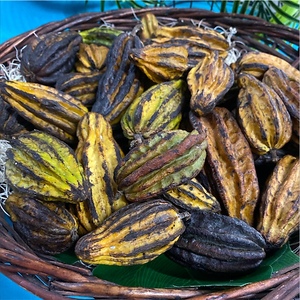


Monkey Cacao Pods
Estimated Inventory, lb : 0
Description/Taste
Monkey Cacao pods are small, varying in size and appearance depending on the specific species, and are generally found 8 to 10 centimeters in length and 3 to 5 centimeters in diameter. The pods have an elongated, ellipsoidal shape, sometimes with a small bump on one end, and are attached to trees through thick, short stalks. Monkey Cacao pods are covered in deeply lobed, prominent ribbing, and the exterior is thick, hard, and dense. They are occasionally covered in fine, prickly hairs or are found smooth, depending on the species. The pods ripen from green to shades of golden yellow with brown markings. Underneath the tough exterior, the pods contain a cavity filled with light brown seeds enveloped in white flesh. The large seeds are typically 1 to 1.5 centimeters in length and are hard, dry, and irregular in shape. The flesh is slippery, succulent, tender, and moist. Monkey Cacao pods are utilized similarly to commercial cacao. The flesh is eaten raw and has a refreshing, sweet, sour, and acidic taste with tropical, lemon-like nuances. When raw, the seeds have a bitter and earthy flavor and are mainly processed into a rich drink.
Seasons/Availability
Monkey Cacao pods are available year-round, with a peak season from December through May, depending on the species and growing environment. In some tropical climates, the pods are also picked from trees in August and September.
Current Facts
Monkey Cacao pods, botanically a part of the Herrania genus, are a category of multiple species that produce showy flowers and edible pods belonging to the Malvaceae family. Herrania species thrive in tropical forests throughout Central and South America and are closely related to Theobroma cacao, commonly known as cacao. There are several species generally labeled under the Monkey Cacao pod name, primarily Herrania imbricata, Herrania purpurea, and Herrania nitida, but there are a few other Herrania species that may also be categorized under the name. Monkey Cacao pods grow on a small understory tree, reaching 3 to 6 meters in height, and the pods grow directly from the slender trunk. Herrania species are known for their showy, unusual flowers. The blooms appear from a bulb on the trunk and crack open to reveal five fleshy petals with long tendrils. The elongated, thin tendrils almost resemble tentacles, and the flowers eventually transform into small ridged pods. Monkey Cacao pods remain firmly attached to the tree for several weeks and are a foraged food among humans and animals. Herrania species are sometimes called Wild Mountain Cacao, Bush Chocolate, Cacao Mono, and Cacao de Monte. Monkey Cacao pods are rare and are challenging to find in retail markets. The pods are not commercially grown and are typically foraged through wild and home garden trees.
Nutritional Value
Monkey Cacao pods have not been studied for their nutritional properties. More research and evaluations need to be conducted before scientific conclusions can be made, and the small pods provide such low amounts of edible elements that their nutritional profile has not been documented.
Applications
Monkey Cacao pods have a sweet, sour, tropical taste suited for fresh preparations. The flesh is primarily consumed straight out of hand and is eaten as a delicacy. The seeds are also edible but not typically eaten raw as they are bitter and unpalatable. The seeds are more commonly processed through fermentation and roasting to enhance the flavor. Once processed, the seeds are ground into a powder or smaller pieces and are blended into beverages. Monkey Cacao seeds are used similarly to common cacao seeds. The seeds are reported to be able to be made into variations of chocolate, and a bitter drink from roasted seeds is prepared and consumed throughout Central and South America. Monkey Cacao pods pair well with cinnamon, cardamom, nutmeg, ginger, almond, peanuts, macadamia nuts, cherries, oranges, lemons, and strawberries. Whole, unopened Monkey Cacao pods will keep for a few days at room temperature or for 1 to 2 weeks in the refrigerator.
Ethnic/Cultural Info
Monkey Cacao pods are rumored to have acquired their name from being a favorite food of monkeys. Historically, monkeys and cacao were intertwined in Mayan folklore. Mayan legend notes that when the gods first created nature, animals, and humans, the creatures had no souls to give back to the gods. Their creation’s lack of worship angered the gods, so they destroyed the living beings. Some beings survived the massacre, and these creatures became known as monkeys. Several indigenous tribes throughout Central America believe monkeys offer visual windows to the past, and these creatures are also closely linked to fertility as they naturally spread cacao seeds, a food connected to fertility in the Mayan Empire. It is said monkeys like to break open cacao pods for the sweet flesh and scatter the seeds by dropping them or through defecation. The seeds then germinate in their scattered location, naturally expanding the cacao’s growing region.
Geography/History
Monkey Cacao pods are native to the Americas and have been growing wild since ancient times. Several species within the Herrania genus are generally categorized under the Monkey Cacao name, and each species has a different center of origin throughout Central and South America. The various species thrive typically in tropical, humid climates in forests at low elevations, and the small trees grow in the understory in shady or partially shady locations. Monkey Cacao pods have remained localized to their sites of origin and have expanded on a small scale throughout the Americas through human intervention and animal seed dispersal. Today, Monkey Cacao pods are not commercially cultivated and are mostly foraged from wild trees. Some specialty growers may also cultivate the pods as a novel culinary ingredient. Monkey Cacao pods are rare and are sold through fresh markets and select distributors in North America, Central America, and South America.








